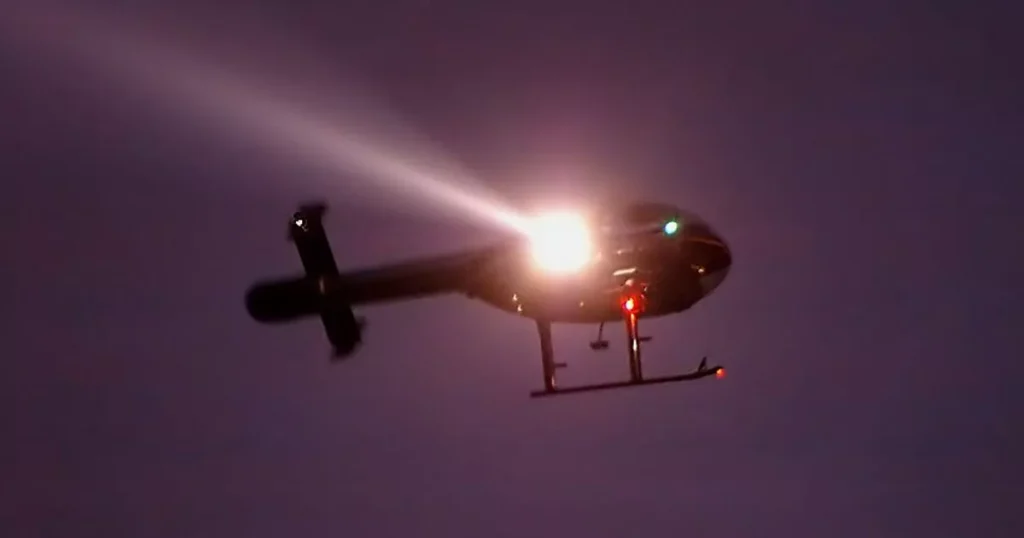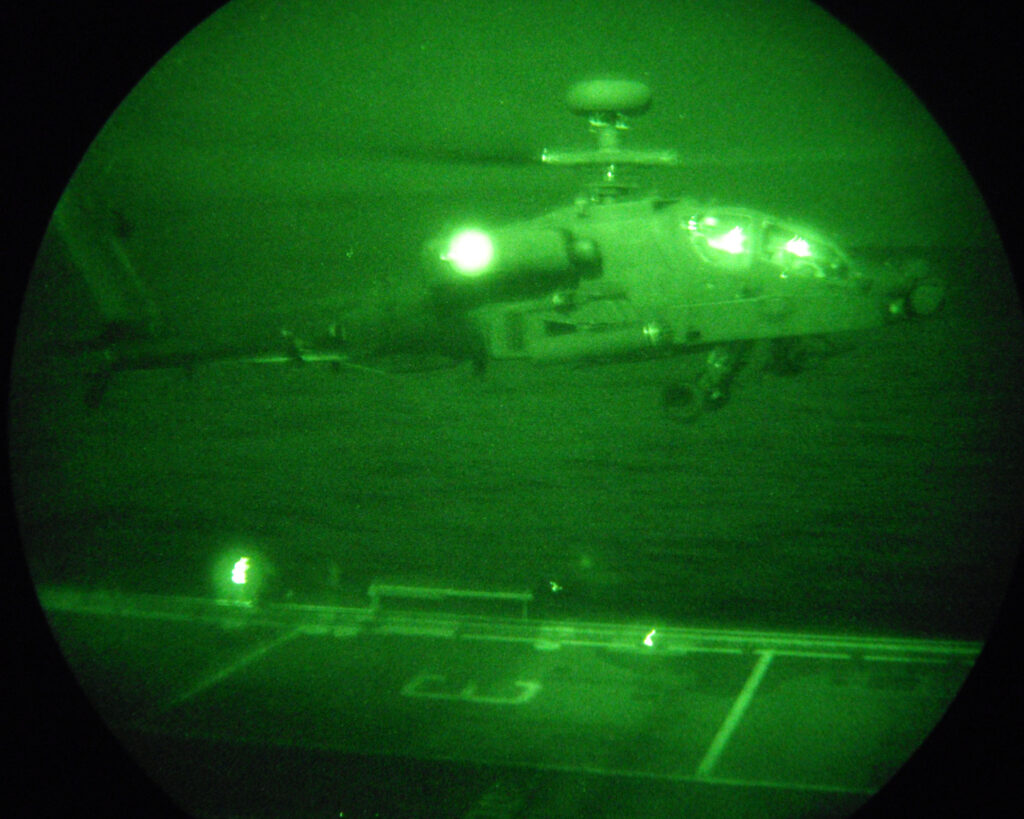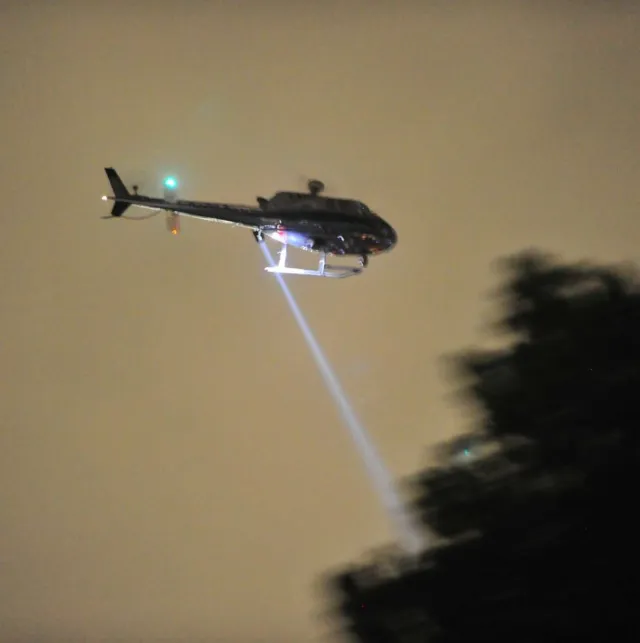Helicopters circle at night in the UK for essential reasons like policing activities, search and rescue operations, and monitoring public safety. The police use them to patrol areas, track suspects, and ensure public safety during nighttime.
They’re also vital for finding missing persons quickly and responding to emergencies. Medical evacuations, military training exercises, and private and commercial flights are other reasons. The circling helps with surveillance, quick responses, and operational readiness.
Additionally, helicopters follow aviation regulations, use safety measures, and balance community concerns by minimizing noise and engaging with residents. Overall, it’s about ensuring safety, providing rapid responses, and supporting various operational needs.
What Are The Reasons for Helicopters Circling at Night?

At night, helicopters circle to help the police watch over neighborhoods, locate missing people, and ensure safety during events. They also assist in quickly transporting sick or injured individuals to the hospital and support the military in training exercises and surveillance.
Law Enforcement and Emergency Services
Policing Activities
Helicopters serve as indispensable tools for law enforcement agencies, conducting aerial surveillance and patrols. During nighttime operations, the elevated perspective allows for efficient monitoring of large areas, aiding in crime prevention and control.
The agility and speed of helicopters make them valuable assets in police pursuits. Circling at night provides enhanced visibility, enabling law enforcement to track suspects and coordinate ground units effectively.
Search and Rescue Operations
Nighttime search and rescue missions benefit from advanced technologies such as thermal imaging and powerful searchlights. These features improve visibility in low-light conditions, increasing the chances of locating individuals in distress.
Helicopters circling at night enable rapid response to emergencies. Whether it’s a missing person or a hiker in distress, the helicopter’s ability to cover large areas quickly is crucial in time-sensitive situations.
Monitoring Public Safety
Helicopters play a vital role in monitoring public events, ensuring crowd safety, and responding promptly to any incidents or emergencies. This is particularly relevant during large gatherings, protests, or major public events.
In the aftermath of natural disasters, helicopters are instrumental in assessing damage, providing aerial support for disaster response teams, and facilitating rescue operations in areas inaccessible by other means.
Medical Evacuations
Transporting Patients to Hospitals
Helicopters provide a critical means of transporting patients in critical condition to hospitals swiftly. This is especially crucial in situations where ground transportation may be impractical or time-consuming.
Nighttime medical evacuations ensure that individuals in need of urgent medical care receive timely interventions, potentially saving lives by reducing transit times.
Emergency Medical Response
Helicopters function as airborne ambulances, responding to emergency medical situations quickly and efficiently. The ability to navigate challenging terrain and reach remote locations is particularly important during nighttime emergencies.
Nighttime medical evacuations play a pivotal role in responding to large-scale accidents or disasters, where immediate medical attention is paramount.
Military Training and Operations
Nighttime Training Exercises
Military helicopters engage in nighttime training exercises to maintain operational readiness. These exercises enhance pilot skills, test equipment functionality, and ensure that military personnel are well-prepared for nighttime operations.
Night training allows military forces to practice stealth operations. Helicopters, equipped with specialized technology, can operate under the cover of darkness, practicing tactical maneuvers and strategies.
Security Operations
Helicopters are integral to military surveillance efforts, patrolling borders and monitoring sensitive areas during nighttime hours. The cover of darkness provides a strategic advantage for surveillance and reconnaissance missions.
Nighttime security operations involve deploying troops, conducting counter-terrorism efforts, and managing border control. Helicopters facilitate rapid and discreet movements, contributing to the effectiveness of security measures.
Commercial and Private Flights
Nighttime Transport of Goods
Commercial helicopters engaged in logistics and supply chain operations often operate at night. This allows for the efficient transport of goods, including time-sensitive deliveries, medical supplies, and perishable items.
Night flights contribute to the maintenance of critical infrastructure by facilitating the transportation of equipment and materials needed for construction, repairs, or other projects.
Private Helicopter Activities
Private helicopters offer executive transportation services, allowing business leaders, VIPs, and individuals with specific needs to travel conveniently during non-daylight hours. This flexibility is particularly valuable for those with demanding schedules.
Some private helicopter operators provide nighttime scenic tours or support events. This offers passengers a unique and breathtaking perspective of cityscapes or landscapes illuminated during the night, creating memorable experiences.
What Aviation Regulations and Safety Measures Govern Helicopter Operations After Dark?
After the sun sets, helicopters follow specific rules and safety measures to fly safely at night. These guidelines include using proper lighting, pilot training, and communication protocols to ensure everyone stays safe in the dark sky.
Requirements for Nighttime Flights
Lighting and Visibility Standards
Aviation authorities set specific requirements for lighting on helicopters during nighttime flights to ensure visibility. This includes illuminated navigation lights and anti-collision lights. Pilots are also required to use aircraft lighting systems in compliance with regulations to enhance visibility to other air traffic and ground personnel.
Instrumentation and Training
Nighttime flying demands additional skills and training for pilots. Aviation regulations often mandate that pilots undergo specialized training for night operations, including instrument flying and navigation using cockpit instrumentation.
Safety Protocols
Weather Consideration
Nighttime flights are subject to weather conditions, and regulations outline safety protocols regarding acceptable weather parameters. Pilots must assess factors such as visibility, cloud cover, and wind conditions to ensure safe operations.
Communication and Coordination
Effective communication between air traffic control, pilots, and ground personnel is crucial during nighttime flights. Safety protocols emphasize clear and concise communication to prevent misunderstandings and enhance situational awareness.
Balancing Operational Needs with Noise Considerations
Noise Abatement Strategies
Helicopter operations, especially during nighttime, raise concerns about noise impact on communities. Regulatory considerations include the implementation of noise abatement strategies, such as flight route planning to minimize over residential areas and the use of quieter helicopter models.
Time Restrictions
Some aviation authorities may impose time restrictions on certain types of helicopter operations in residential zones to mitigate noise disturbances during sensitive hours, allowing a balance between operational needs and community well-being.
Community Engagement and Awareness
Dialogue with Residents
Addressing community concerns involves proactive engagement and open communication. Helicopter operators may engage with local residents, providing information about flight schedules, purposes, and measures taken to minimize noise impact. Establishing dialogue fosters understanding and collaboration.
Educational Initiatives
Aviation authorities may implement educational initiatives to raise awareness within communities about helicopter operations. This includes educating residents about the necessity of certain nighttime flights, their frequency, and the safety measures in place to alleviate concerns and build trust.
How does night vision technology contribute to safer nighttime helicopter operations?

Night vision technology plays a pivotal role in enhancing the safety and effectiveness of nighttime helicopter operations through advanced imaging capabilities designed to overcome the challenges posed by low-light conditions.
Enhanced Visibility
Night vision technology utilizes specialized sensors that can capture and amplify existing ambient light, including moonlight and starlight, to generate a visible image. This enables pilots to see the surrounding environment more clearly than with the naked eye in near-total darkness.
Obstacle Detection
In low-light environments, identifying obstacles such as terrain features, power lines, and other aircraft becomes challenging. Night vision technology assists by highlighting these potential hazards, allowing pilots to navigate around them effectively and reducing the risk of collisions.
Improved Situational Awareness
The technology provides pilots with a broader and clearer view of their surroundings, contributing to heightened situational awareness. This is crucial for making informed decisions, especially in dynamic and rapidly changing scenarios or emergency situations.
Search and Rescue Operations
Night vision technology is particularly valuable during search and rescue missions. It enables pilots to locate individuals or vessels in distress, even in remote or dark areas, facilitating quicker and more precise responses to emergencies.
Military Operations
In military helicopter operations, night vision technology is integral to executing covert and strategic maneuvers. It enables military pilots to operate in darkness, maintaining a tactical advantage and executing missions with precision.
Instrument Flight Training
Pilots undergo specialized training for instrument flight using night vision technology. This training is crucial for maintaining proficiency in flying solely by reference to instruments, a skill essential for navigating in low-visibility conditions.
Reduced Dependency on External Lighting
Night vision technology reduces the reliance on external lighting sources, allowing helicopters to operate more discreetly during nighttime missions. This is particularly important for law enforcement, military, and other operations where maintaining a low profile is beneficial.
Integration with Cockpit Systems
Modern helicopters often integrate night vision technology with cockpit systems, providing real-time data and imagery directly to the pilot’s display. This integration streamlines the information flow and enhances the overall effectiveness of the technology in supporting safe flight operations.
FAQ
Why is a helicopter circling my area at night in the UK?
Helicopters may circle at night for various reasons, such as police patrols, medical emergencies, or search and rescue missions. They aim to ensure public safety and respond to situations requiring immediate attention.
Why would a helicopter fly at night without lights?
Helicopters flying without lights at night often engage in covert or military operations. It’s a safety measure to maintain a low profile and execute missions discreetly.
Why do army helicopters fly at night?
Army helicopters operate at night for tactical reasons. Night operations provide a strategic advantage, allowing military forces to conduct missions with reduced visibility and surprise potential threats.
Can helicopters fly at night in the UK?
Yes, helicopters can fly at night in the UK. They adhere to safety regulations and may conduct various operations, including law enforcement, medical assistance, or transportation, depending on the situation.
How low can a helicopter fly legally in the UK?
The legal minimum altitude for helicopters in the UK is 500 feet (150 meters) unless taking off or landing. However, helicopters may fly lower if necessary for safety reasons or specific operational requirements.
Can airplanes fly at night?
Yes, Airplanes are equipped to fly day and night. They use navigation lights and advanced technology for safe nighttime operations. Airlines regularly schedule flights during the night, offering passengers flexibility and reaching their destinations around the clock.
Final thoughts
On the whole, helicopters circling at night in the UK serve vital roles in ensuring safety, responding swiftly to emergencies, and supporting diverse operations. From policing and medical evacuations to military training and commercial activities, their presence is driven by necessity.
While following strict aviation regulations, safety measures, and addressing community concerns, these nighttime flights contribute to public welfare, security, and operational readiness.

